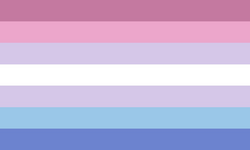Bigender: Difference between revisions
No edit summary |
No edit summary |
||
| Line 4: | Line 4: | ||
| meaning = - Pink: Woman<br>- Blue: Man<br>- Purple: Androgyne/mix of woman and man<br>- White: agender. | | meaning = - Pink: Woman<br>- Blue: Man<br>- Purple: Androgyne/mix of woman and man<br>- White: agender. | ||
| related = [[androgyne]], [[trigender]], [[multigender]] | | related = [[androgyne]], [[trigender]], [[multigender]] | ||
| percentage = | | percentage = 4.6 | ||
| gallery_link = Pride Gallery/Bigender | | gallery_link = Pride Gallery/Bigender | ||
}} | }} | ||
Revision as of 18:11, 25 July 2018
 Meaning - Pink: Woman - Blue: Man - Purple: Androgyne/mix of woman and man - White: agender. | |
| Related identities | androgyne, trigender, multigender |
|---|---|
| Click here to see alternative flags! | |
Bigender, or bi-gender, is a gender identity under the multigender, nonbinary, and transgender umbrella terms. Bigender people have two distinct gender identities, either at the same time, or at different times. The latter is a form of genderfluid identity, and may involve only two distinct genders, or it may involve "shades of gray between the two."[1] The two genders of a bigender person can be the two binary genders, female and male. This is what people usually assume bigender means. However, some people who identify as bigender have a different pair of genders. For example, their two genders might be female and neutrois. Or the two genders might be both nonbinary, such as agender and aporagender. Bigender is recognized by the American Psychological Association (APA) as a subset of the transgender group.[2]
History
A 1999 survey conducted by the San Francisco Department of Public Health observed that, among the transgender community, less than 3% of those who were assigned male at birth and less than 8% of those who were assigned female at birth identified as bigender.[3]
In 2012, Case and Ramachandran gave a report on the results of a survey of genderfluid people who call themselves bigender who experience involuntary alternation between female and male states. Case and Ramachandran gave this condition the name "Alternating gender incongruity (AGI)." Case and Ramachandran made the hypothesis that gender alternation may reflect an unusual degree (or depth) of hemispheric switching, and the corresponding suppression of sex appropriate body maps in the parietal cortex. They said that "we hypothesize that tracking the nasal cycle, rate of binocular rivalry, and other markers of hemispheric switching will reveal a physiological basis for AGI individuals' subjective reports of gender switches... We base our hypotheses on ancient and modern associations between the left and right hemispheres and the male and female genders."[4][5][6] These doctors think that when bigender people feel a change between their gender identities, it might have to do with a change in how they use parts of their brains. The gender change might also have to do with one of the cycles that everyone has in their body, specifically, a valve in the nose that changes sides every two days (the nasal cycle). This is only a hypothesis, meaning that it is an interesting idea that doesn't have proof for now.
In 2014, bigender was one of the 56 genders made available on Facebook.[7]
In 2015, an entry for "bigender" was added to Dictionary.com,[8] defined as "a person who has two gender identities or some combination of both."[9]
Gender expression
Bigender people "move between feminine and masculine gender-typed behaviour depending on context. Some bigendered individuals express a distinctly ‘en femme’ persona and a distinctly ‘en homme’ persona […] others have shades of grey between the two."[10]
See also
External links
- Bigender.net
- Wikipedia's Bigender article
- Bigender at Gender Wiki
- Susan's Place Transgender Resource Wiki: Bigender
References
- ↑ Schneider, M., et al. APA Task Force on Gender Identity, Gender Variance, and Intersex Conditions, 2008 http://www.apa.org/topics/sexuality/transgender.pdf (PDF)
- ↑ Schneider, M., et al. APA Task Force on Gender Identity, Gender Variance, and Intersex Conditions, 2008 http://www.apa.org/topics/sexuality/transgender.pdf (PDF)
- ↑ Clements, K. "The Transgender Community Health Project." San Francisco Department of Public Health. 1999. http://hivinsite.ucsf.edu/InSite?page=cftg-02-02
- ↑ Case, L. K.; Ramachandran, V. S. (2012). "Alternating gender incongruity: A new neuropsychiatric syndrome providing insight into the dynamic plasticity of brain-sex". Medical Hypotheses 78 (5): 626–631. doi:10.1016/j.mehy.2012.01.041. PMID 22364652. https://www.ncbi.nlm.nih.gov/pubmed/22364652
- ↑ "Bigender - Boy Today, Girl Tomorrow?". Neuroskeptic. April 8, 2012. http://neuroskeptic.blogspot.com/2012/04/bigender-boy-today-girl-tomorrow.html
- ↑ Stix, Gary (2012-04-20). "'Alternating Gender Incongruity' Causes Rapid Shifts Of Gender, Scientist Claims". The Huffington Post. http://www.huffingtonpost.com/2012/04/19/alternating-gender-incongruity_n_1438911.html
- ↑ Eve Shapiro, Gender circuits: Bodies and identities in a technological age. Unpaged.
- ↑ "New words added to Dictionary.com." May 6, 2015. http://blog.dictionary.com/2015-new-words/
- ↑ "Bigender." Dictionary.com. Retrieved May 18, 2015. http://dictionary.reference.com/browse/bigender
- ↑ Schneider, M., et al. APA Task Force on Gender Identity, Gender Variance, and Intersex Conditions, 2008 http://www.apa.org/topics/sexuality/transgender.pdf (PDF)
| |
This page, licensed as CC-BY-SA 4.0, has been imported from the old nonbinary.wiki using the same or a compatible license. It is part of nonbinary.wiki's import of the original Nonbinary Wiki and is licensed under CC BY 3.0. |
